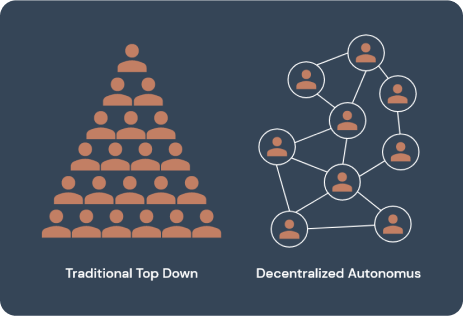A Guide To: Web 3.0
March 3, 2021
Analyst Team
01. Glossary of Terms
02. Web 3.0 Overview
03. Non-Fungible Tokens
04. Decentralized Finance
05. Decentralized Autonomous Organizations
06. MTP House View
01. Glossary of Terms
Sector:
Non-Fungible Tokens: Unique digital assets. Their basis on blockchain enables higher quality of ownership and authenticity verification. Initial examples focus on art, collectibles, tokenised communities, but use cases will extend to any opportunity requiring a digital contract. (e.g., Crypto Punks, Bored Ape Yacht Club, NBA Top Shots).
DeFi:
Decentralised Finance: Blockchain-based finance, not reliant on centralised entities like banks, exchanges, brokers etc.
Social Tokens:
These are fungible (i.e., universally interchangeable). They are a type of cryptocurrency that are based around a brand, community, or influencer. Incentivise network effects as members benefit from the strength of the community.
DAOs:
Decentralised Autonomous Organisations: these are entities controlled by their membership, where the community rules are encoded as a transparent computer programme.
Metaverse:
A virtual reality space in which users can interact with a computer generated environment and other users. Essentially, it is the 3D version of the internet.
The world of Web 3.0 is hard to keep up with, given the break neck speed of its growth. Our Lead Investment Analyst, Tobias Howarth, provides a summary of all things Web 3.0 and investigates the investment opportunities.
02. Web 3.0 Overview
Web 3.0 is the next phase in the world wide web’s evolution. Web 1.0 was ‘read-only’, with static pages and no user interaction. Web 2.0, the current, participative web, allows users to interact with one another, but a few firms control large walled gardens and have monetised user data. Web 3.0 will be immersive and composed of decentralised applications that run on blockchain technology and utilise smart contracts.
The ability of web 3.0 to process information, operate machine learning, and write smart contracts will allow full automation of any activity usually conducted on the internet. Similarly, the metaverse, a visual, 3D representation of the internet and a core component of web 3.0, blurs the lines between reality and digitality, with users’ avatars acting out their reality-based internet activity in a digital universe.
03. Non-fungible Tokens
Non-fungible tokens (NFTs), the most visible incarnation of Web 3.0, enjoyed a banner year in 2021. NFTs began to emerge in the investing public’s consciousness in the early months of 2021, with Beeple’s Crossroads selling for USD 6.6mn. A month later, Beeple, a popular NFT artist, sold his Everydays piece for USD 69.3mn – an NFT record. An NFT is a unique piece of data, usually presented as easily-reproducible items, such as art, that uses blockchain technology to administer proof of ownership to the unique file. Over 2021, NFTs have become increasingly popular, with celebrities and sports teams alike releasing their own exclusive tokens and NFT sales volumes grew to USD 25bn by December 2021.
We anticipate a gradual tapering of the hype surrounding NFTs, especially digital artwork, across the first half of the new year. The underlying concept of NFTs, however, will persist. The proof of ownership model can be used to democratise access to artwork, protection of creators’ royalty rights, and the proof of authenticity of other assets, both digital and analogue. As an example, alongside Prada and Cartier, Louis Vuitton established its own authenticity blockchain, Aura, in 2019; reducing the profitability of the counterfeit market.

04. Decentralised Finance
Decentralised Finance, or DeFi, projects, such as Aave, Avalanche, Cardano, and Chainlink use blockchain technology, and automated smart contracts, to remove the bureaucracy and middlemen usually found in traditional financial services, such as lending and trading. Transaction fees and the influence of large corporations are minimised; democratising access and increasing affordability. As of November 2021, transaction volumes on DeFi protocols had reached USD 300bn per month; illustrating the value of the market.
Paradigm One and Andreessen Horowitz, amongst others, have both raised billion dollar funds aimed exclusively at expanding the ecosystem of token based applications and DeFi protocols. In 2021, 72 DeFi protocol start-ups were backed by investors globally, a 25% increase from 2020; this trend is anticipated to continue at pace throughout this year.
We acknowledge the thesis that distributed ledger technology will supplant traditional finance and fiat currency. We see the legacy and challenger forms of finance learning to coexist and adapt to each other’s presence out of necessity in the near term.
05. DAOs
Web 3.0 is still in its infancy, but the growth in popularity of decentralised autonomous organisations, or DAO, suggest that elements of web 3.0 are certain in the near future. A DAO’s decentralisation redefines corporate ownership. Each participant is issued an ownership contract and receives a token to mark their stake in the DAO.
One principle of DAO is the transparency of governance, so each token holder has voting power in strategic decision making processes.
As a DAO is founded on blockchain technology, smart contracts can be used to automate business operations. The capabilities of a DAO, at least to the degree

of full automation of business, are currently limited. An interesting concept currently gaining traction, however, is the use of DAO as a form of a democratic venture fund. The established DAO is used to pool the crypto assets of its members, and each member has an equal vote on where those assets should be invested.
06. MTP House View
We view the proliferation of retail NFTs and cryptocurrencies as a necessary first wave, and expect a residual opportunity set to emerge around the underlying rails, or digital infrastructure, that support the Web 3.0 eco-system. Platforms, such as Aave and Coinbase, which facilitate the lending and trading of crypto coins, and OpenSea, which is the most prominent NFT marketplace, serve as examples of this infrastructure.
Web 3.0 is still an embryonic concept, but the universe of potential applications continues to expand. MTP are excited by the space and the opportunity to build infrastructure to support the Web 3.0 ecosystem.